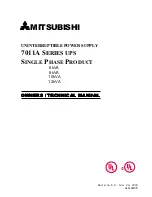
MITSUBISHI ELECTRIC 7011A SERIES UPS
MITSUBISHI
ELECTRIC
7011A SERIES UPS
OWNERS / TECHNICAL MANUAL
Page Number:
1-4
1.2 DEFINITIONS
UNINTERRUPTIBLE POWER SUPPLY SYSTEM (UPS)
- All components within the UPS
Module Cabinet and associated batteries which function as a system to provide continuous,
conditioned AC power to a load. This is sometimes referred to as the "System".
UPS MODULE CABINET
- The metal enclosure which contains Converter & Inverter
Module, I/O Module, batteries, and operator controls required to provide specified AC power
to a load.
CONVERTER & INVERTER MODULE
- The Converter / Charger and Inverter assembly
which, under the direction of the I/O Module and operator controls, provide specified AC
power to a load.
I/O MODULE
– Assembly which contains Static Transfer Switch, the internal bypass line,
and the internal control system. With operator controls, gives directions required to the
Converter & Inverter Module to provide specified AC power to a load.
CONVERTER / CHARGER
- The UPS component which contain the equipment and controls
necessary to convert input AC power to regulated DC power required for battery charging
and for supplying power to the Inverter.
INVERTER
– The UPS component which contain the equipment and controls necessary to
convert DC power from the Converter / Charger, or the battery, to AC power required by the
critical load.
STATIC TRANSFER SWITCH
- Device which connects critical load to the bypass line when
the Inverter cannot supply continuous power.
MAINTENANCE BYPASS LINE
- Line which conducts electricity directly from the input power
source to the critical load during maintenance or whenever the UPS is not completely
operational.
AC INPUT POWER
- Power provided by the electrical utility company, or auxiliary generator,
which is connected to the UPS for supplying critical load and recharging the battery.
BATTERY -
Rechargeable battery strings which supply DC power to the inverter to maintain
continuous AC power to the load during AC input power failure conditions.














































